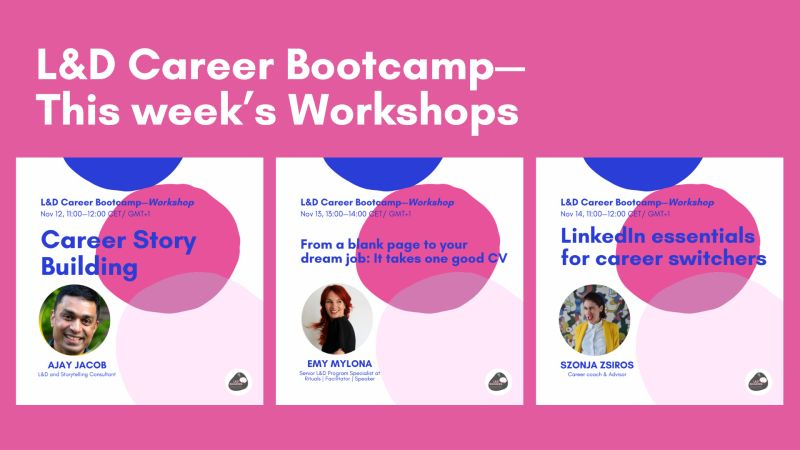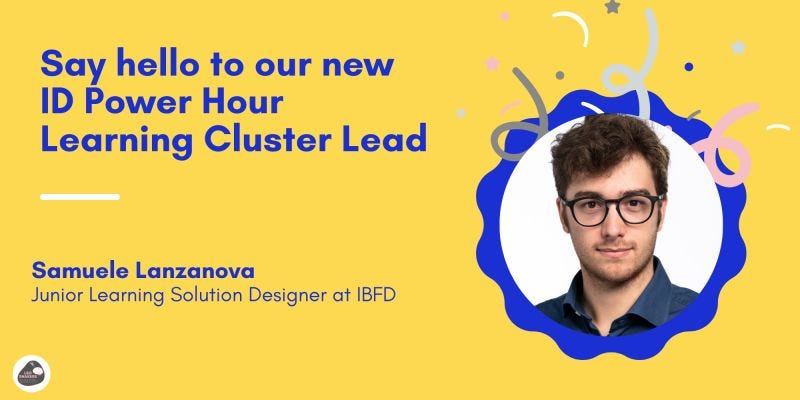TLB #42🧠 Tapping into the science of learning!
A bi-weekly inside scoop on all the hottest events, juicy discussions, and oh-so-many other exciting things happening in our dynamic L&D community. 🧡
Hello Shaker,
Here’s all that you’ll experience in today’s issue:
💡Learning Bites: Unlocking your brain’s learning superpowers
🗓️ Community Calendar: Be a part of Wellbeing Hour 🌱 Happiness on a plate—Using Acceptance and Commitment Therapy and many more local meet-ups happening.
🖌️ Community Creations: Welcoming Samuele Lanzanova as the new Learning Cluster Lead for the ID Power Hour.
🔖 Resource Reel: A collection of resources on Workshop, Organisational Behaviour, Team Building and many more.
Learning Bites 💡
What if I told you that the way you learned to ride a bike as a child holds the key to mastering complex skills as an adult? Or that our brains are wired to learn through simulations—much like how pilots train in flight simulators before stepping into a real cockpit?
Understanding how our brains learn can revolutionize the way we teach, train, and develop ourselves and others. Whether you’re looking to improve your team’s performance, design engaging learning experiences, or just learn something new yourself, unlocking the science of learning can make all the difference. Knowing how to harness the brain’s natural learning processes can make your interventions more impactful, help your team adapt faster, and even boost your personal growth.
Stanislas Dehaene’s book How We Learn: Why Brains Learn Better Than Any Machine . . . for Now unveils that human learning is not just about absorbing information; it’s about transforming perceptions into deeper understanding through active engagement, simulations, and feedback loops. Our brains are constantly refining internal models of the world, allowing us to learn quickly, adapt to new challenges, and apply knowledge in flexible ways.
Top Three Takeaways
Learning Transforms Perception into Knowledge: Learning goes beyond simply collecting facts—refining our mental models. For example, the way we navigate our neighbourhoods or recognize familiar faces is based on complex, dynamic simulations our brains create. Dreams, too, are a byproduct of this: they’re our brains’ way of rehearsing and refining these mental models.
Human Learning Outpaces AI in Complexity and Flexibility: While AI might excel in processing massive data sets, it still lacks the nuanced understanding and adaptability humans naturally possess. A child can learn a language with just a few interactions, while AI models need thousands of data points. The human brain’s efficiency in learning from minimal data is still unmatched.
Education Unleashes Cognitive Potential: Education’s power lies in transforming basic human abilities into sophisticated skills like reading and mathematics. For instance, studies on literacy reveal that it doesn’t just teach us to recognize letters—it enhances our memory, spatial recognition, and even the ability to distinguish mirror images.
What This Means for Practice:
Prioritize Active Learning Over Passive Consumption
⏤Ditch the traditional “sit-and-listen” lecture format. Instead, design activities where learners actively engage with the material—through case studies, role-plays, or problem-solving exercises. Like letting participants resolve a team conflict or make strategic business decisions.
⏤Incorporate peer-led discussions where participants teach or present key concepts to others on different challenges in groups.
Leverage Feedback Loops for Continuous Learning
⏤Build in reflection and feedback moments throughout your experience. Include moments for them to self-assess on the topic that you are taking them through and also on their progress in between the sessions if time and chance permit.
⏤Utilize reflective prompts like, “What’s one thing you will do differently after today’s session?” or “How would you apply this concept to a current challenge you’re facing?”
Design Real-World Simulations and Hands-on Activities
⏤Replicate real-life conditions where learners can practice skills in a safe environment. This is particularly effective for complex skills like negotiation, project management, or customer service.
Integrate Social Learning to Enhance Engagement
⏤Encourage collaborative learning through group activities, peer feedback sessions, and community forums. People learn best when they interact, share knowledge, and reflect together.
Here are some additional resources that you can explore at your own pace.
That’s all Shakers! This week reflect on what is one skill you've learned in this year so far? How did you learn it, and what methods helped you the most?
Coming Up Next
Community Calendar 🗓️
Our upcoming events are just around the corner, designed to inspire and inform. Make sure you're on the list—register using the link given below!
Do you know we are running L&D Career Bootcamp? Do you know what participants are saying about it? Check this out! 😍 Join us for the second week!
Community Creations 🖌️
We’re thrilled to announce that Samuele Lanzanova is stepping in as the new Learning Cluster Lead for the ID Power Hour, taking the reins from the incredible Damla Sürek, who launched this vibrant space over a year ago.
Samuele, we wish you an amazing journey in this new role—we’re delighted to have you onboard. And Damla, thank you for your dedication and passion in bringing ID Power Hour to life.
Cool Stuff You Don’t Wanna Miss Out
Resource Reel 🔖
When to workshop by Jemma Frost where talks about how knowing when to run a workshop is as important as knowing how to run a workshop.
The Kool-Aid Factory is a collection of zines that talks about the coordination mechanisms organizations rely on to get the work done.
The 10 Best Canvases for Culture Design and Team Building is a collection of the most downloaded culture design canvases created by Gustavo Razzetti.
how we feel a journal for your well-being where you check in to track your emotions and spot the patterns as they appear over time.
How to apply product management principles to learning design where the author talks about the ways to test ideas quickly, gather meaningful feedback, and scale what works to drive real performance change.
How good is your Feedback Culture by Kristina Kmieliauskaite where she lists out the behaviours of highly functioning Feedback Cultures flex, check out what can you see your in culture.
Influencing culture – A skills-based approach where the author shares the Leadership backbone skills framework and describes how to infuse perspective taking one of the skills of the framework for faster progress on strategic challenges, better decision making, gains in market share, ability to include new individuals/competences to mention some.
〜See you soon
Till then, keep spicing up your learning! 🧠🧂
Sejaal








Dehaene’s How we Learn was the best book I read on learning. So good!!